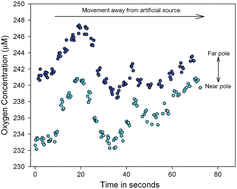Self-referencing optrode technology for non-invasive real-time measurement of biophysical flux and physiological sensing†
Abstract
Vibrating probe technology has enabled scientific investigations that have expanded our knowledge of form and function in biology, but the emergence of new fields of cytomics and physiomics will require new technologies to probe the functional realm of living cells. In this paper, we present the development of a self-referencing optrode, which represents the next generation of biophysical flux sensors based on phase-sensitive detection for cell and tissue physiology. One key advantage is that optical approaches do not suffer from the inherent electrical artifacts which limit the performance of traditional vibrating, or self-referencing probe technology. In self-referencing modality, the optrode is oscillated (0.1 Hz) between two points a few microns apart in a concentration gradient, converting the optrodic oxygen concentration sensor into a dynamic flux sensor, based on Fick's law. Because of the inherent noise and drift filtering associated with phase-sensitive detection it is now possible to measure pico-molar flux levels using a micro-optrode. In this paper, we show the calibration, characterization and application of the self-referencing oxygen optrode for measuring biophysical oxygen flux.


 Please wait while we load your content...
Please wait while we load your content...